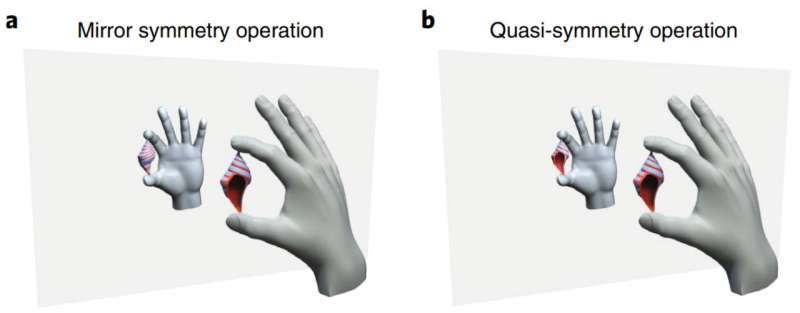
Since the discovery of the quantum Hall effect, symmetry has been the guiding principle in the search for topological materials. An international team of researchers from Germany, Switzerland, and the U.S. have introduced an alternative guiding principle that leads to the discovery of a new type of topological material with great potential for applications in spintronics and quantum technologies. Nature Physics has published this work.
The quasi-symmetry operation acts on different parts of the system, unlike a proper symmetry which acts on the whole object uniformly. An incomplete mirror image is an example in which some parts of an object are not mirrored. It corresponds to a system that has exact symmetry when only the basic approximation is taken into account, but additional approximative terms break such symmetry. In the electronic band structure of a solid, there are finite but parametrically small energy gaps at some low-symmetry points.
In their new work, the researchers show that the quasi-symmetry in the semi-metal CoSi can be used to fix energy gaps over a large plane. The electrons are bent into a circular motion by a magnetic field. The application of in-plane strain breaks the crystal symmetry which gaps only the corresponding degenerate points but the quasi-symmetry-protected points remain intact. One of the most important features of quasi-symmetry is its robustness against chemical and physical perturbations.
Most of the materials discovered in recent years need precise engineering of their chemical composition for them to be relevant in the future. The need for fine tuning is eliminated by quasi-symmetries as the features can be found at any arbitrary chemical potential. The quasi-symmetry-protected materials are strong against any physical changes. A key prerequisite for their technological application via thin-film processes is the robust nature of quasi-symmetry-protected topological materials.
These features show a new class of materials with increased resilience, which simplifies their use in technology. The researchers believe that the first example represents an important step towards uncovering topological materials beyond the usual space group classifications, which could help the community not to overlook what may be hidden in plain sight.
More information: Chunyu Guo et al, Quasi-symmetry-protected topology in a semi-metal, Nature Physics (2022). DOI: 10.1038/s41567-022-01604-0 Journal information: Nature Physics Citation: Quasi-symmetry in CoSi reveals new type of topological material (2022, May 19) retrieved 19 May 2022 from https://phys.org/news/2022-05-quasi-symmetry-cosi-reveals-topological-material.html This document is subject to copyright. Apart from any fair dealing for the purpose of private study or research, no part may be reproduced without the written permission. The content is provided for information purposes only.